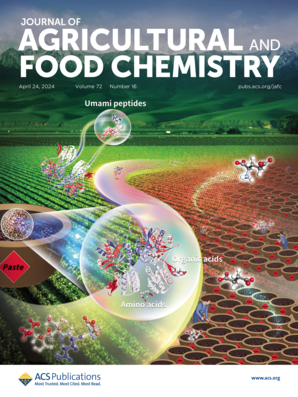Electrochemical Sensing toward Noninvasive Evaluation of High-Starch Food Digestion via Point-of-Use Monitoring Glucose Level in Saliva
IF 5.7
1区 农林科学
Q1 AGRICULTURE, MULTIDISCIPLINARY
引用次数: 0
Abstract
To provide individuals with healthier and more reliable dietary recommendations for diabetic patients, a pragmatic electrochemical sensing toward in situ monitoring of glucose in saliva was designed for noninvasive evaluation of high-starch food digestion. The proposed sensor was constructed by exploiting a carbon-based nanostructure for electrical conductivity and Ni-based nanozyme toward direct catalytic oxidation of glucose for signal output. Particularly, the catalytic host–guest interaction between nanozyme and glucose was investigated to be a hydrogen bond via molecular docking, and the C11 and O5 sites in the glucose molecule were attacked during host–guest catalytic reaction through density functional theory (DFT) research. With merits of simplicity, sensitivity, and accuracy, the electrochemical sensor exhibited good performance for monitoring glucose with a detection limit of 10 μM (corresponding to 1.8 μg mL–1). Moreover, it was well qualified to point-of-use trace glucose levels in saliva, offering a promising tool for noninvasive evaluation of high-starch food digestion (e.g., Wheat bread, Steamed bun, and Shao-mai) at different times after meals and eventually yielding benefits to dietary recommendations for diabetic patients.

通过监测唾液中的葡萄糖水平,电化学传感对高淀粉食物消化的无创评估
为了给糖尿病患者提供更健康、更可靠的饮食建议,设计了一种实用的电化学传感器,用于唾液中葡萄糖的原位监测,用于无创评估高淀粉食物的消化。该传感器是利用碳基纳米结构的导电性和镍基纳米酶直接催化葡萄糖氧化的信号输出来构建的。特别是,通过密度泛函理论(DFT)研究了纳米酶与葡萄糖之间的催化主-客体相互作用是通过分子对接形成的氢键,葡萄糖分子中的C11和O5位点在主-客体催化反应中受到攻击。该电化学传感器具有简单、灵敏、准确等优点,检测限为10 μM (1.8 μg mL-1),具有良好的葡萄糖监测性能。此外,它还能很好地测定唾液中的微量葡萄糖水平,为饭后不同时间对高淀粉食物(如小麦面包、馒头和烧麦)的消化提供了一种有前途的无创评估工具,并最终为糖尿病患者的饮食建议提供了有益的建议。
本文章由计算机程序翻译,如有差异,请以英文原文为准。
求助全文
约1分钟内获得全文
求助全文
来源期刊
CiteScore
9.90
自引率
8.20%
发文量
1375
审稿时长
2.3 months
期刊介绍:
The Journal of Agricultural and Food Chemistry publishes high-quality, cutting edge original research representing complete studies and research advances dealing with the chemistry and biochemistry of agriculture and food. The Journal also encourages papers with chemistry and/or biochemistry as a major component combined with biological/sensory/nutritional/toxicological evaluation related to agriculture and/or food.

 求助内容:
求助内容: 应助结果提醒方式:
应助结果提醒方式:


